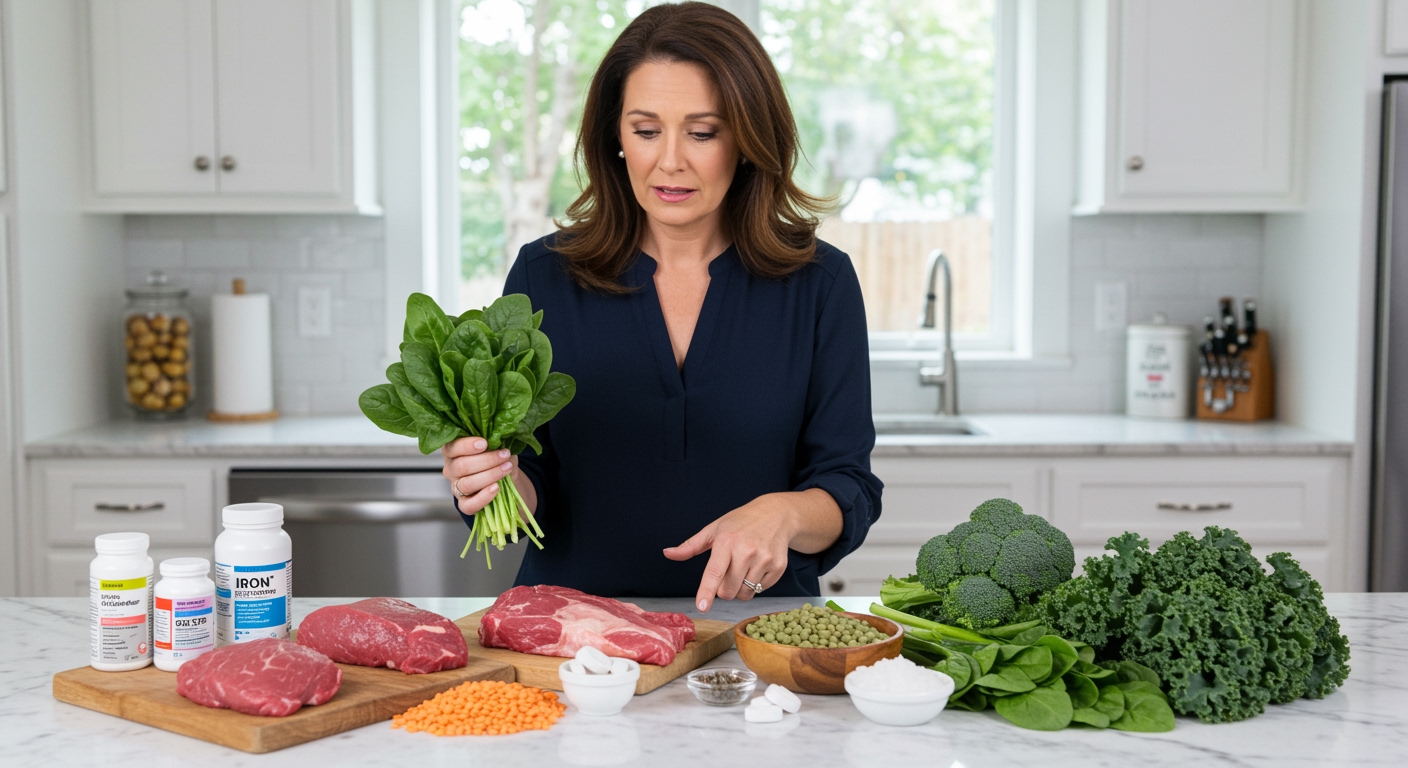✪ Key Takeaway: Oxalates in spinach and dark leafy greens bind with iron, preventing your body from absorbing most of the iron these foods contain.
Introduction
Your doctor tells you to eat more spinach for iron, but your iron levels keep dropping.
This happens because dark green vegetables contain compounds called oxalates that actually block iron absorption in your digestive system. The very foods we think will boost our iron levels might be working against us in ways most people never realize.
Hi, I’m Abdur, your nutrition coach and today I’m going to explain how dark green vegetables can sabotage your iron absorption and what you can do about it.
What Are Oxalates And How Do They Work?
Oxalates are natural compounds found in many plant foods, especially dark leafy greens like spinach, kale, and Swiss chard.
These compounds serve as a defense mechanism for plants, protecting them from being eaten by animals and insects. When you consume oxalate-rich foods, these compounds travel through your digestive system and can bind with minerals like iron, calcium, and magnesium.
The binding process happens in your small intestine, where most nutrient absorption takes place.
When oxalates attach to iron molecules, they form insoluble complexes that your body cannot break down or absorb. This means the iron passes through your digestive system without entering your bloodstream.
Research shows that spinach contains about 750 milligrams of oxalates per 100 grams, making it one of the highest oxalate foods in our diet.
The irony is that spinach also contains decent amounts of iron, but the oxalates prevent most of it from being absorbed.
✪ Fact: Only about 2% of the iron in spinach can actually be absorbed by your body due to oxalate interference.
Which Dark Green Vegetables Are The Worst Offenders?
Not all dark green vegetables contain the same amount of oxalates, and knowing which ones are highest can help you make better choices.
Spinach tops the list with the highest oxalate content, followed by Swiss chard, beet greens, and rhubarb leaves. These vegetables can contain anywhere from 500 to 1,500 milligrams of oxalates per serving.
Kale and collard greens contain moderate amounts of oxalates, while vegetables like broccoli, Brussels sprouts, and cabbage have much lower levels.
The processing method also matters significantly for oxalate content and iron absorption.
Raw spinach contains higher levels of active oxalates compared to cooked spinach, because cooking can break down some of these compounds and make the remaining iron slightly more available.
However, even cooked spinach still contains enough oxalates to significantly impair iron absorption, so cooking alone does not solve the problem completely.
✪ Pro Tip: Choose broccoli and Brussels sprouts over spinach when you need both iron and vitamin C for better absorption.
How Much Iron Are You Actually Missing?
The numbers might shock you when you realize how much iron you think you are getting versus what your body actually absorbs.
A cup of cooked spinach contains about 6.4 milligrams of iron, which looks impressive on paper. However, due to oxalate interference, your body can only absorb approximately 0.1 to 0.2 milligrams of that iron.
This means you would need to eat about 50 cups of spinach to get the same amount of absorbable iron as you would from a small 3-ounce serving of lean beef.
The situation becomes even more problematic when people rely heavily on green smoothies or large salads as their primary iron sources.
Many health-conscious individuals consume multiple servings of high-oxalate greens daily, thinking they are boosting their iron intake, when they might actually be creating a net negative effect on their iron status.
Studies show that people following plant-based diets who consume large amounts of oxalate-rich vegetables often develop iron deficiency despite eating foods that appear iron-rich on nutritional labels.
✪ Note: Nutritional labels show total iron content, not the amount your body can actually absorb from that food.
What Can You Do To Improve Iron Absorption?
You do not have to completely avoid dark green vegetables, but you need to be strategic about how and when you consume them.
First, separate your iron-rich meals from your high-oxalate vegetables by at least two hours. This prevents the oxalates from binding with iron from other foods in your digestive system.
Second, pair iron-rich foods with vitamin C sources like citrus fruits, bell peppers, or strawberries, which can help overcome some of the absorption barriers created by oxalates.
Third, choose lower-oxalate green vegetables like broccoli, bok choy, and lettuce when you want to combine greens with iron-rich foods in the same meal.
Fourth, consider cooking methods that can reduce oxalate content, such as boiling and discarding the cooking water, which removes some of the water-soluble oxalates.
Finally, if you are at risk for iron deficiency, focus on getting iron from animal sources like lean meats, fish, and poultry, or from iron-fortified foods that do not contain natural oxalates.
✪ Pro Tip: Drink your green smoothie between meals rather than with iron-rich foods to minimize absorption interference.
The Bottom Line
Dark green vegetables contain oxalates that significantly reduce iron absorption, making them unreliable sources of this essential mineral despite their iron content on paper.
The healthiest approach is not to avoid these vegetables entirely, but to understand their limitations and plan your meals accordingly. You can still enjoy the many other benefits of dark leafy greens while getting your iron from more reliable sources.
I would love to hear about your experiences with iron levels and green vegetables in the comments below. Have you noticed any changes in your energy levels when you adjusted your green vegetable intake?
References
At NutritionCrown, we use quality and credible sources to ensure our content is accurate and trustworthy. Below are the sources referenced in creating this article:
- Iron Disorders Institute: Diet and Iron Absorption
- PubMed: Iron Absorption from Spinach
- Compound Chemistry: The Chemistry of Spinach
- McGill University: Setting the Facts Straight About Iron in Spinach

